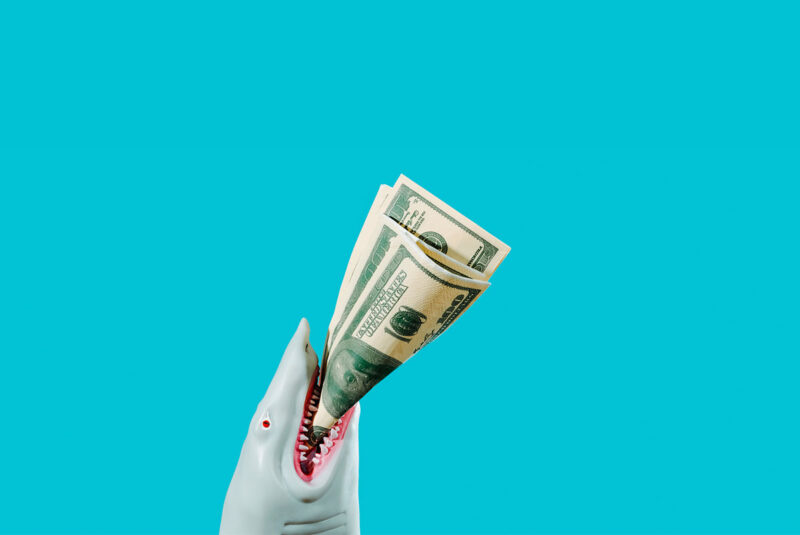Imagine, if you will, a pickle barrel at a grocery store. It’s filled with pickles you can take out, put in a bag and pay for. Of course, you only pay for the pickles you take out. And once you eat the pickles you bought, you can buy more pickles – again and again – until the barrel is empty.
A line of credit works in much the same way. A lender (like a bank, a credit union or an online lender) lets you borrow a predetermined sum of money you can draw from when you need it. You use as much or as little of the money as you choose, only paying interest on the cash you access. Of course, whatever you use must be paid back with interest.
There are three common types of lines of credit: a personal line of credit, a home equity line of credit (HELOC) and a business line of credit. But what are the differences between them?
That’s what we’re here to tell you.
You’ll learn everything you’ve ever wanted to know about lines of credit, from the different types to how you use them.
What Is a Line of Credit and How Does It Work?
A line of credit is a popular loan that operates a lot like a credit card. It’s a revolving credit account that gives you access to a set amount of money (think of it as your credit limit) you can draw from for a fixed number of years. The advantage of a line of credit over a traditional loan is its flexibility. Rather than receive a lump sum of money that immediately starts accruing interest, as you would with a traditional loan, a line of credit allows you to borrow what you need when you need it. And you only pay interest on what you borrow.
A line of credit has two distinct periods: a draw period and a repayment period.
Draw period
The draw period is the time frame a lender sets when you can repeatedly withdraw money from your line of credit. The length of the draw period will depend on the lender, but draw periods generally last 5 – 10 years.
Repayment Period
The repayment period follows the draw period. During this phase, you pay back what you borrowed from your line of credit plus interest. Depending on the lender and the line of credit, you’ll usually have 3 – 20 years to pay off your remaining balance.
What Are Unsecured and Secured Lines of Credit?
Lines of credit can be unsecured or secured. An unsecured line of credit requires no collateral. A secured line of credit, like a HELOC, requires collateral – such as property, a car or investments – to secure the loan.
Unsecured line of credit
An unsecured line of credit doesn’t require collateral (an asset you provide to secure a loan). Instead, your approval is based on financial data like your credit score, income and debt-to-income (DTI) ratio.
Because there’s no collateral the lender can seize if you default on your loan, unsecured lines of credit typically have higher interest rates than secured lines of credit.
Secured line of credit
A secured line of credit requires collateral. Let’s say you take out a home equity line of credit (a HELOC), which is a secured line of credit. The collateral is in the name: It’s your home. A business line of credit is usually secured. Business assets like equipment or property typically serve as collateral for the loan.
A lender can seize the collateral if the loan defaults. Because the lender can recover any potential losses with a borrower’s collateral, secured lines of credit tend to have lower interest rates than unsecured lines of credit.
What Are the Different Types of Lines of Credit?
When most borrowers take out a line of credit, it’s usually a personal line of credit, a home equity line of credit (HELOC) or a business line of credit.
Personal Line of Credit
A personal line of credit is a flexible way to get cash you can use for any purpose. You can use it for large expenses like unexpected medical bills or a roof replacement. You can use one to fund a long-term home renovation project or a wedding. You can also use it to consolidate debt.
Personal lines of credit can be unsecured or secured, but they are typically unsecured. The draw period and repayment period for a personal line of credit will vary by lender, but each period tends to last between 3 – 5 years.[1]
How do I qualify for a personal line of credit?
Qualifying for a personal line of credit will depend on the lender, but you’ll usually need:
- Good Credit: A credit score of at least 670 or higher gives you the best chance of getting the best loan terms. If you have a low credit score, your interest rate will likely be higher.
- A qualifying debt-to-income (DTI) ratio: Typically, lenders will want to see a maximum DTI of 36%, but some lenders may consider a DTI as high as 50%.
- Strong personal finances: A lender wants to be sure you can pay back a loan on time. To help determine your reliability as a borrower, lenders will ask for proof of income and employment and review your credit report.
PROS of a Personal Line of Credit👍
You may be able to get your personal line of credit approved in a day or up to a week.
You can use your line of credit for virtually anything.
CONS of a Personal Line of Credit👎
Personal lines of credit generally have lower interest rates than credit cards, but their rates typically range from 8.25% to 15%.[1]
Most personal lines of credit have a variable interest rate. That means the rate can increase or decrease based on market conditions. Because the rate is unpredictable, it can make budgeting to repay a loan a lot more challenging. And because interest rates can go up, you could potentially pay more in interest than when you first took out the loan.
Home Equity Line of Credit (HELOC)
A HELOC, also known as a second mortgage, is a revolving line of credit that allows a homeowner to borrow against the equity in their home, which is your home’s appraised value minus what you owe on your mortgage.
A HELOC is a secured loan, and your home acts as the loan’s collateral. And it works like other lines of credit: You borrow from your loan amount whenever you need to and only pay interest on what you borrow.
HELOCs are typically used for home improvement projects. With these kinds of projects, expenses tend to come up over time, and you’re never really sure how much the project will cost until the very last bill is paid. You can also use a HELOC to pay off emergency bills, pay off student loans or to consolidate debt.
The draw period for a HELOC will vary by lender, but a typical draw period lasts 5 – 10 years, and the repayment period is usually 20 years.
How do I qualify for a HELOC?
Qualifying for a HELOC generally requires:
- Enough equity: Typically, you’ll need at least 20% equity in your home (which, incidentally, is the standard recommended down payment on a mortgage). Depending on the lender, you can usually borrow up to 85% of the equity in your home.
- Good credit: Lenders typically require a credit score of at least 680 to qualify for a HELOC.[2] The higher your score, the better loan terms and lower interest rates you may qualify for.
- A qualifying debt-to-income (DTI) ratio: Lenders may require a maximum DTI of 36%, though some lenders may accept a DTI up to 50%. Lenders will also check other aspects of your finances, including your income, employment and credit history.
PROS of a HELOC👍
Because HELOCs are secured loans, their interest rates tend to be lower than unsecured lines of credit.
You may be able to deduct interest if you use the funds to improve the home. “Luxury upgrades” like a swimming pool aren’t tax deductible.
Depending on the amount of equity in your home, there may be a lot of money for you to borrow. For instance, if you have $100,000 in home equity, you may be able to borrow up to $85,000.
CONS of a HELOC👎
Your home is the collateral for the loan. If you default on the loan, the lender may seize and sell your home to recover what’s owed on the loan.
If you borrow against your equity, you’ll lower the amount of equity you built in your home.
Once the repayment period begins, you’ll have to budget for your monthly HELOC payment and your monthly mortgage payment.
Business Line of Credit
With a business line of credit, borrowers get a fixed loan amount from a lender (usually up to $250,000)[3] they can repeatedly tap into for a variety of purposes, including equipment purchases, office space expansion or even making payroll during a cash crunch.
Business lines of credit tend to be unsecured, so the business does not have to put up property or assets as collateral. Like other unsecured lines of credit, the interest rate is higher than it would be for secured lines of credit.
How do I qualify for a business line of credit?
Qualifying for a business line of credit is a little different than qualifying for a personal line of credit or a HELOC. Lenders will often look at both your personal and your business financial information to assess your creditworthiness for a business line of credit.
What you’ll need to qualify will vary by lender, but you’ll usually need to provide:
- A business credit report and score: Three major business credit bureaus each compile business credit reports: Dun & Bradstreet CreditMonitor™, Experian™ Business and Equifax® Business. The reports measure the financial health of your business. They contain information reported by business credit card issuers and lenders and list any bankruptcies. The information in the reports is used to generate a business credit score from 1 – 100. The higher the score, the more creditworthy your business appears to lenders. Lenders typically prefer to see scores in the 80 – 100 range.
- Your personal credit: In the event a business doesn’t have a business credit report or credit score, a lender will review your personal credit score instead. Some lenders will want to see both. Lenders may accept a personal credit score of 580, but some lenders will require a personal credit score of 670 or higher.[4]
- Tax returns and financial statements: Your lender will check your business revenue and finances to determine whether you make enough to pay back the loan and whether your source of revenue is consistent. Generally, lenders will want to see at least $25,000 in annual business revenue.
- Length of time in business: Some lenders will require that you’ve been in business for at least 6 months. Other lenders will require that you’ve been in business for at least 2 years.
- Other debts: A lender will need to assess your total business debt load compared to your revenue.
PROS of a Business Line of Credit👍
A business can usually deduct the interest paid on a business line of credit.
Typically, a business can borrow up to $250,000.
Cash is king in business. A line of credit can ensure access to cash when you need it.
CONS of a Business Line of Credit👎
A line of credit will increase your business debt. It could affect operations or discourage investors or other lenders.
Many lines of credit have fees that add up.
It’s Your Line
Let’s go back to the pickle barrel analogy we used at the beginning of this article. Pickles, like lines of credit, come in a few varieties. Lines of credit come in three “flavors”: personal lines of credit, HELOCs and business lines of credit. Each variety will appeal to different borrowers with different financing needs.
The Short Version
- With a line of credit, you get a set amount of money to tap into when you need it instead of receiving a lump sum
- There are three common types of lines of credit: a personal line of credit, a home equity line of credit (HELOC) and a business line of credit
- An unsecured line of credit requires no collateral. A secured line of credit, like a HELOC, requires collateral – such as property, a car or investments – to secure the loan
Experian™. “What Is a Line of Credit?” Retrieved May 2022 from https://www.experian.com/blogs/ask-experian/what-is-a-line-of-credit/
Experian™. “What is a Home Equity Line of Credit?” Retrieved May 2022 from https://www.experian.com/blogs/ask-experian/what-is-a-home-equity-line-of-credit-heloc/
Experian™. “Business Loan or Business Line of Credit: Which Is Best For You?” Retrieved May 2022 from https://www.experian.com/blogs/ask-experian/business-loan-vs-business-line-of-credit-whats-the-difference/
Experian™. “What is a Business Line of Credit?” Retrieved May 2022 from https://www.experian.com/blogs/ask-experian/what-is-a-business-line-of-credit/




